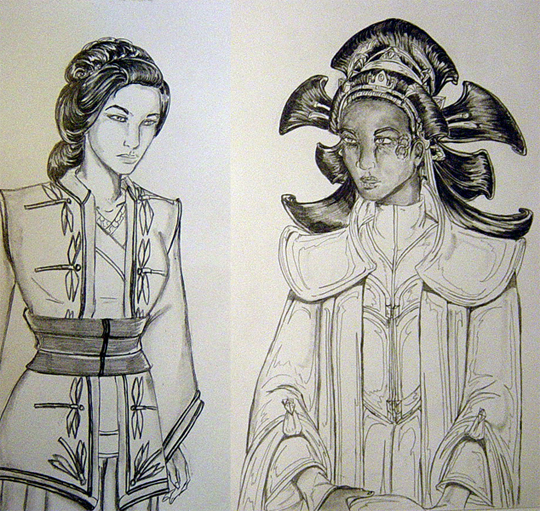Note: this article first appeared as a guest blog post in Scientific American with only the top accompanying image.
 Recently, two studies surfaced almost simultaneously that led to exclamations of “Vulcan mind meld!”, “Zombie armies!” and “Brains in jars!” One is the announcement by Rajesh Rao and Andrea Stocco of Washington U. that they “achieved the first human-to-human brain interface”. The other is the Nature paper by Madeline Lancaster et al about stem-cell-derived “organoids” that mimic early developmental aspects of the human cortex. My condensed evaluation: the latter is far more interesting and promising than the former, which doesn’t quite do what people (want to) think it’s doing.
Recently, two studies surfaced almost simultaneously that led to exclamations of “Vulcan mind meld!”, “Zombie armies!” and “Brains in jars!” One is the announcement by Rajesh Rao and Andrea Stocco of Washington U. that they “achieved the first human-to-human brain interface”. The other is the Nature paper by Madeline Lancaster et al about stem-cell-derived “organoids” that mimic early developmental aspects of the human cortex. My condensed evaluation: the latter is far more interesting and promising than the former, which doesn’t quite do what people (want to) think it’s doing.
The purported result of brain interfacing hit many hot buttons that have been staples of science fiction and Stephen King novels: primarily telepathy, with its fictional potential for non-consensual control. Essentially, the sender’s EEG (electroencephalogram) output was linked to the receiver’s TMS (transcranial magnetic stimulation) input. What the experiment actually did is not send a thought but induce a muscle twitch; nothing novel, given the known properties of the two technologies. The conditions were severely constrained to produce the desired result and I suspect the outcome was independent of the stimulus details: the EEG simply recorded that a signal had been produced and the TMS apparatus was positioned so that a signal would elicit a movement of the right hand. Since both sender and receiver were poised over a keyboard operating a video game, the twitch was sufficient to press the space bar, programmed by the game to fire a cannon.
Here’s a partial list of problems with the wide-bore conclusion of “Mind meld!”: 1) The space bar is by far the largest keyboard item, as well as the one closest to the user’s fingers. I bet that if the desired move had been programmed by, say, one of the tiny F keys, the results would be negative. 2) It’s unclear that input specifics mattered. The obvious control is to see if any EEG signal (or a computer simulation of an EEG signal without a human at its end) gives the same result with an identical TMS setup. If yes, we’re back to square zero. If no, further experiments would be interesting and useful, though still extremely limited for applications. 3) The response was a reflex action, not a thought-induced one. This makes the setup an inefficient and Pentagon-expensive on/off switch, not a method to elicit fine-tuned actions.
The overall result, complicated input/output paraphernalia notwithstanding, is par with having frog legs twitch when they receive an electric current, or with people’s legs jerking when hit at the knee with a doctor’s hammer. To his credit, Rao pointed out that this is not a technique for thought transfer. Such technology may well end up enabling people who are paralyzed by either accident or disease to exert some control over basic commands, if the setup can be made less cumbersome. Most certainly it’s not a preamble to “passengers landing planes when the pilot is incapacitated”, as touted by Stocco. Passengers in such jeopardy would do better to stick with the traditional frantically shouted instructions shown in all those Airport movies. And the zombie army plans will have to be put on hold.
So what about disembodied masterminds that could control these zombie armies? Lancaster et al developed experimental conditions under which either embryonic (ESC) or induced pluripotent (iPS) stem cells differentiate into small balls that exhibit several of the properties of embryonic cortex. These include migration of the proto-neuronal cells to form laminar structures (which in real brains go on to become such compartments as the hippocampus) and bursts of electrical activity that are sensitive to cognate neurotoxins. The organoid attributes resemble those of a bona fide brain but aren’t the same. Additionally, they are limited in size and further development/self-organization by the intrinsic absence of the micro- and macro-contexts of native brains during their formation.
The fundamental premise of this research is not novel: it extends the trial-and-error attempts of cell biology to induce desired cellular properties and structures in culture. It is an interesting stroke of random luck that ESCs and iPSs are (relatively!) easy to turn into proto-neurons. Given the experimental parameters, such structures will almost certainly never recapitulate a full-size, fully functional brain even if they’re given 3-D scaffolds and circulating nutrients that mimic blood supplies. However, brain organoids derived from iPS cells of humans suffering from brain disorders are tremendous assets for figuring out what goes awry in specific contexts. Lancaster et al already did a neat (and directly relevant) proof of principle: they demonstrated phenotype-congruent differences in organoids cultivated from the skin of a microcephaly case caused by a mutation in CDK5RAP2. Among its functions, this protein regulates the mitotic spindle and hence the crucial balance between cell proliferation and differentiation – vital not only for cancer, but also for correct brain development.
This new tool in our kit promises to bypass two major bottlenecks in basic and applied biomedical research: work with “equivalence” models in non-humans is strewn with species-specific artifacts and limitations, whereas research on humans is fraught with moral dilemmas. In other words, it will allow us to identify human-specific details that make the difference in truly understanding and eventually short-circuiting diseases that are unique and critical to us – brain malformation and deterioration most prominently among them. Furthermore, it will do so without destroying embryos, making its funding less of a political football than usual.
So the outcome of this type of research will not be masterminds in silicon jars, but better maintained brains in carbon bodies. This is modest, prosaic – but real and concrete, unlike the overhyped “mind melds” which will have a hard time catching up with (let alone overtaking) our fine-tuned, sophisticated tool for such endeavors: language.

Sources and further explanations:
Direct Brain-to-Brain Communication in Humans: A Pilot Study
Lancaster MA, Renner M, Martin C-A, Wenzel D, Bicknell LS, Hurles ME, Homfray T, Penninger JM, Jackson AP, Knoblich JA (2013). Cerebral organoids model human brain development and microcephaly. Nature doi:10.1038/nature12517.
Cloning Brains with Science. PZ Myers, Pharyngula, Aug. 29, 2013
Images: Top, Ghost in the Shell showcases both “brains in jars” and “mind melds”; bottom, Spock mind-rapes Valeris in The Undiscovered Country.





